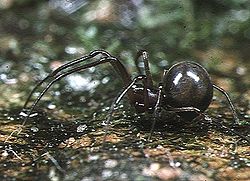Anapidae: Difference between revisions
Luckas-bot (talk | contribs) m r2.7.1) (robot Adding: ms:Anapidae |
m r2.7.1) (Robot: Adding es:Anapidae |
||
| Line 96: | Line 96: | ||
[[ca:Anàpid]] |
[[ca:Anàpid]] |
||
[[es:Anapidae]] |
|||
[[fr:Anapidae]] |
[[fr:Anapidae]] |
||
[[it:Anapidae]] |
[[it:Anapidae]] |
||
Revision as of 18:10, 13 March 2012
| Anapidae | |
|---|---|

| |
| female Conculus lyugadinus from Okinawa | |
| Scientific classification | |
| Kingdom: | |
| Phylum: | |
| Class: | |
| Order: | |
| Suborder: | |
| Superfamily: | |
| Family: | Anapidae Simon, 1895
|
| Genera | |
|
see text | |
| Diversity | |
| 35 genera, 145 species | |

| |
The Anapidae are a family of rather small spiders with 145 described species in 35 genera. Most species are less than 2 mm long[1].
In some species (such as Pseudanapis parocula) the pedipalps of the female are reduced to coxal stumps[1].
Anapidae generally live in leaf litter and moss on the floor of rain forest. Many build orb webs with a diameter of less than 3 cm.[1]
Distribution
Most genera inhabit New Zealand, Australia and Africa. However, several genera occur in Asia (Japan, China, Korea). Only Comaroma simoni and the three species of Zangherella are found in Europe; Gertschanapis shantzi and Comaroma mendocino live in the USA.[2]
Systematics
Although the Micropholcommatidae were synonymized with this family by Schütt (2003), this move was not followed by most researchers.
Genera

- Anapis Simon, 1895 — Central to South America
- Anapisona Gertsch, 1941 — Central to South America
- Caledanapis Platnick & Forster, 1989 — New Caledonia
- Chasmocephalon O. P-Cambridge, 1889 — Australia
- Comaroma Bertkau, 1889 — Europe, USA, China, Korea, Japan
- Conculus Komatsu, 1940 — New Guinea, Korea, Japan
- Crassanapis Platnick & Forster, 1989 — Chile, Argentina
- Crozetulus Hickman, 1939 — Africa
- Dippenaaria Wunderlich, 1995 — South Africa
- Elanapis Platnick & Forster, 1989 — Chile
- Enielkenie Ono, 2007 — Taiwan
- Forsteriola Brignoli, 1981 — Africa
- Gertschanapis Platnick & Forster, 1990 — USA
- Hickmanapis Platnick & Forster, 1989 — Tasmania
- Mandanapis Platnick & Forster, 1989 — New Caledonia
- Maxanapis Platnick & Forster, 1989 — Australia
- Metanapis Brignoli, 1981 — Africa, Nepal
- Minanapis Platnick & Forster, 1989 — Chile, Argentina
- Montanapis Platnick & Forster, 1989 — New Caledonia
- Nortanapis Platnick & Forster, 1989 — Australia
- Novanapis Platnick & Forster, 1989 — New Zealand
- Octanapis Platnick & Forster, 1989 — Australia
- Paranapis Platnick & Forster, 1989 — New Zealand
- Pecanapis Platnick & Forster, 1989 — Chile
- Pseudanapis Simon, 1905 — Central and South America, Africa, South Asia, New Guinea, Hong Kong
- Queenslanapis Platnick & Forster, 1989 — Australia
- Risdonius Hickman, 1939 — Australia
- Sheranapis Platnick & Forster, 1989 — Chile
- Sinanapis Wunderlich & Song, 1995 — China
- Sofanapis Platnick & Forster, 1989 — Chile
- Spinanapis Platnick & Forster, 1989 — Australia
- Tasmanapis Platnick & Forster, 1989 — Tasmania
- Victanapis Platnick & Forster, 1989 — Australia
- Zangherella Caporiacco, 1949 — Mediterranean
- Zealanapis Platnick & Forster, 1989 — New Zealand
See also
Footnotes
References
- Ramirez, M.J. & Platnick, N.I. (1999): On Sofanapis antillanca (Araneae, Anapidae) as a kleptoparasite of austrochiline spiders (Araneae, Austrochilidae). Journal of Arachnology 27(2): 547-549. PDF
- Murphy, Frances & Murphy, John (2000): An Introduction to the Spiders of South East Asia. Malaysian Nature Society, Kuala Lumpur.
- Schütt, K. (2003): Phylogeny of Symphytognathidae. Zoologica Scripta 32: 129–151.
- Platnick, Norman I. (2008): The world spider catalog, version 8.5. American Museum of Natural History.
